As a homesteader, we try to make every piece of our land both beautiful and functional. In other words, it basically either makes food or energy, and serves a greater ecological function in our land. After it ticks all those boxes, it also hopefully looks pretty.
In this regard, when I bought my property, it had a swimming pool. It just irritated me. It was always full of leaves, went green at the drop of a hat, used a few kwh a day in power for the filter, and most of the time, I never even swam in it. It was a source of constant irritation, did nothing good and used my time, money and energy and served no ecological function at all.
After spending an evening distilling and having a few quiet quality control samples I thought – wouldn’t it be nice if I can use this pool as a fish farm and make a rice paddy to work as the filter?
And thus, the aquaponic paddy was born. The first few attempts at getting the process to work were unsuccessful, and hence this article helps you avoid making those mistakes and rather jump straight to a functional rice paddy swimming pool “Aquaponipaddy” system.
Related: DIY Water Filter
The Logic
Fish are good to eat, but make the water dirty.
Rice is good to eat and cleans the water.
Put the two together, and you have a balanced system.
We will go into the ecological bonuses you get out of balancing this equation at the end. This is not just an eco pool, it is an integrated system where the maximum number of steps in the process produce food, ecological services and beauty.
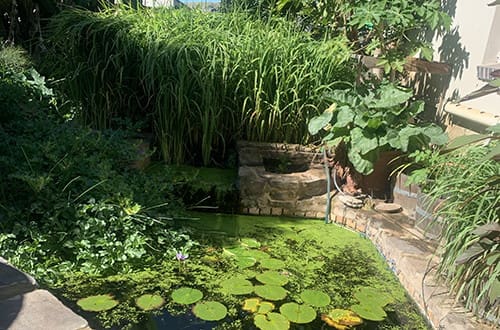
Skill Level Required
Basic DIY – know how to use an electric screwdriver, hammer, mix cement and concrete, etc.
All of this, even if you do not know it, is either explained on the back of the cement bag, or on YouTube somewhere.
Materials Needed For The Aquaponics
Shutter boards – to shape your concrete.
Cement, sand, stone to make concrete.
Scrap iron/rebar/fencing to reinforce your concrete.
Geotextile or geomat material to line the structure.
Plastic lining.
A small fountain pump to circulate water.
Assorted rocks to make it look pretty.
Rice seed (more on that later).
River sand and some manure to create your paddy soil and stop leaks.
The Construction
Step 1: Cast a flat concrete base – use reinforcing metal to ensure that the base does not crack. In my case the slab is 3.5 m (11.5 ft) wide by 4 m (13.1 ft) in length approximately.
Step 2: After the concrete slab has set, cast the walls onto the-setup. I cast the walls so as to allow a 350 mm (13.5”) depth of the paddy.
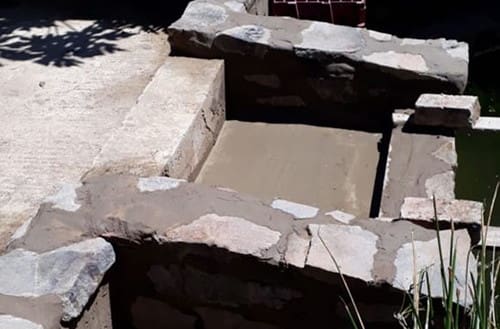
Step 3: Place plastic membrane into the paddy and cover this with geotextile/geomat material and cast a layer of cement over this. I did this so that if any micro cracks appear in the system, the plastic and geomat work to ensure there are no major leaks. Manure tends to flow into cracks and bacteria grow on it and it forms a black anaerobic plug that largely stops leaks.
Step 4: Beautify by cementing rocks or tiles to the surfaces.
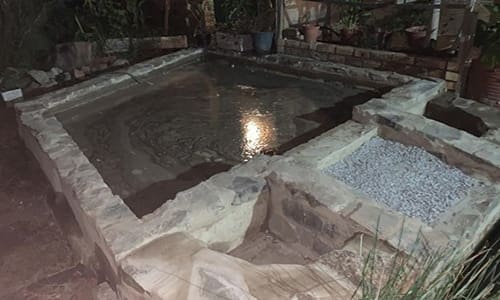
Preparation For Planting
Place a container with a little bit of soil and a layer of water 25 mm(1”) over the soil on a windowsill in late winter.
Throw a few handfuls of rice seed into the container. This will germinate and develop into a bed of small rice plants which can be transplanted at a later date.
Prepare the paddy by layering a layer 20-30 mm ( 1-1.2”) thick of manure on the floor of the paddy. Overlay this with river sand to a depth of 20 cm (8”) or so. This gives you a 20 cm (8”) soil bed, and enough above this for water of a depth of 150 mm (5.5”).
Set the pump from the pool running, so that it circulates water into the paddy and back into the pool.
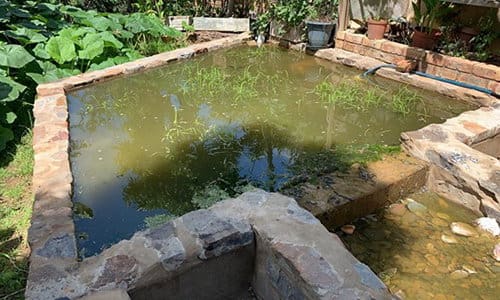
Planting
Plant the rice as thickly as possible. It is easy to subtract rice later, but difficult to add. So rather have more than less. I have made the mistake of underplanting in the first year, and this reduced the efficacy of the system.
Ideally, you can plant at very high density of over 60 plants per m2 as the system is nutrient rich.
This allows you to rapidly get the plant biomass to cover the water surface and remove nutrients.
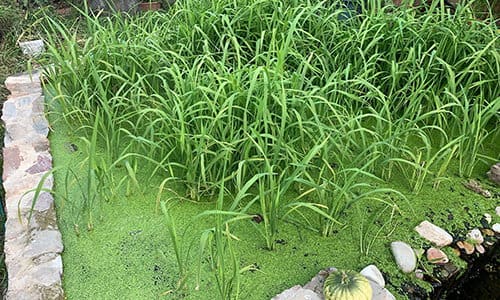
Operation
Stock your pool with a moderate loading of fish. The fish provide nutrients to the rice. My pool has a nominal volume of 6000 l (1500 gal) and I stock at a loading of 80 Oreochromis mossambicus tilapia with a weight of 150 g/fish (5.2 Oz). This works out at about 12 kg (26.5 lb) of tilapia in the pool – over the growth season the tilapia gain rapidly in weight, and typically I look to triple to quadruple the input. Hence a harvest of 36 to 48 kg of tilapia fish is quite attainable. The growth in fish coincides with an increase in size, and therefore ability to remove nutrients and clean water of the rice.
I also stock the pool with 5 kg goldfish/koi, and if available a carp or two. Your carp/koi/goldfish clan of fish, are great eaters of waste food. Carp/koi/Goldfish make great cat food.
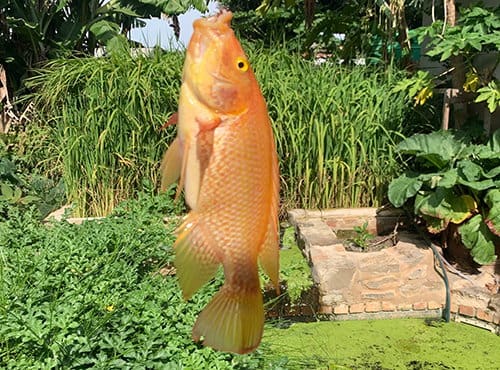
From time to time, I have had a few eels in the pool. These eat any dead fish and taste fantastic. The current eel is 1.5 m long and will probably grow for another year to about 2 m in length and about 10 kg or so in weight.
For surface feeding and to control mosquitoes, I place guppies into the pool. These are excellent surface feeders, and towards the end of the season as the temperature drops, they become food for the other fish specifically the eels.
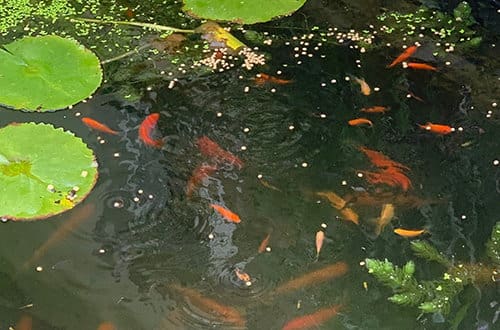
If possible, I find it is ideal to have a small surface water plant, such as lemna/wolffia in your rice paddy. This grows rapidly, and washes into the pool, where the tilapia eat it.
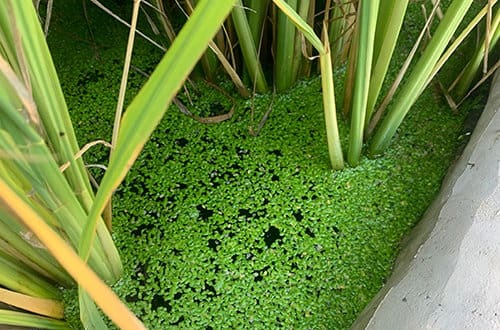
In the paddy it also helps to have a water weed like Elodea (check if these are legal in your area). These weeds provide a large surface area for bacteria that clean the water to immobilize. As the rice grows this weed will eventually be smothered but in the early stages of rice growth, the water weed does more work cleaning the water than the rice. This changes as the season progresses.
Harvest
The cultivar of rice I grew is an old African land race from Malawi – Kilombero sticky rice. An authentic tilapia tastes much better than the mass-produced garbage fish one can purchase. I believe a tilapia should take no longer than 10 minutes from pond to pot. Something goes horribly wrong in the taste if you take longer than this.
I typically harvest the rice and tilapia at about the same time in late autumn. The temperature in the pool drops rapidly, and although I have a wood fired pool heater that can lift the temperature of the pool to tropical temperatures year round, it is very energy intensive and time intensive to make fires to heat the pool in winter, and it is better just to harvest the fish and eat them.
The rice in my experience yields about a kilogram per square meter planted, which gives me a yield of 9-10 kg a year of kilombero rice. This is more than enough if you are on a low carb diet. Processing the rice is a bit of a job, but well worth it and the taste of fresh brown home-grown rice is a special experience.
Ecological Outputs
The rice paddy attracts frogs, toads and dragon flies as well as other aquatic invertebrates. The tadpoles produced are an excellent cleaning system for the pond, and towards harvest time, you will find your garden inundated in baby frogs and toads. These provide an excellent ecosystem service eating slugs, snails and the frogs control flying pests like cucurbit fly that plague squash plants.
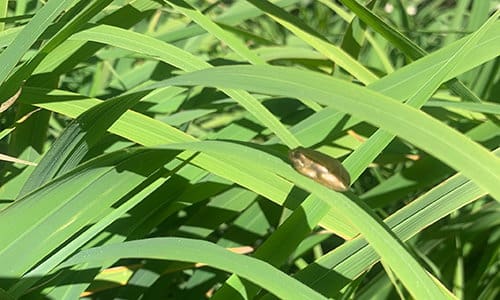
Dragon flies emerge throughout the season – the dragon fly nymphs thrive in the roots of the rice and are voracious predators, eating mosquito larvae when young, and guppies and tadpoles as they get older. When the dragon fly emerges as an adult and flies off it will eat flying insects such as mosquitoes and plant pests. I typically count 20 or so dragon flies a day emerging from the paddy for the peak summer months, hence this is a serious ecosystem service.
You may also like:
 Is It Legal To Harvest Rainwater In Your State?
Is It Legal To Harvest Rainwater In Your State?
An Insanely Effective Way to Build a 5 Year Food Stockpile (Video)
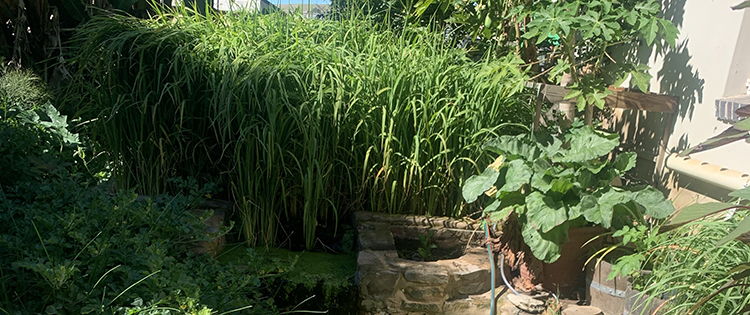

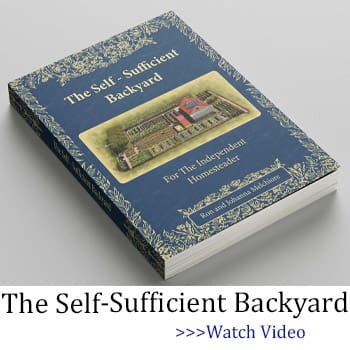






This is amazing!! We have a ~35 sq foot little pond fountain. I’m wondering how this will work out on a smaller scale. Also curious about growing things other than rice. I’ll have to research more and experiment! Thanks!
You can use a solar water heater to keep the temp up in the winter. With a two-stage system, you can easily get 180 degrees F for the water or anti-freeze in the 1st section, and then with a couple of turns of copper coil, you can run the water from the pond through that and get quite comfortable temps from it. Then you will only need the wood-fired water heater on really cold spells.
Thank you for sharing! I’ve been considering an aquaponics system for years now and just been wondering about logistics, like during cold months. It makes sense to harvest and wait.
Two questions came up: first, I assume you freeze the extra fish? Or do we just harvest daily for several weeks? Second, would this work with pond liners instead of concrete for those of us without a pool, and to reduce environmental impact?
Thanks again!
Hi Shelly, thank you for the questions.
For the fish, I tend to just catch fish as needed. They keep growing the longer they stay in the water, and the bigger the fish, the lower the ratio of bones to meat. So, especially with the barbel – my target is to let them get as big as possible.
Regarding pond liners: yes it works quite well with these. I tend to use a geo-textile membrane, paint that with water proofer, then put pig mesh wire on top of that and a thin layer of cement, I have built a much bigger dam in my garden that uses this alternative method for sealing, and this dam produces a lot of fish biomass as well.
Could you please reply as to what type of Climate you have? I thought Tilapia had to be kept at 80 degrees F or above all the time! Thanks
Can you use these ponds to also raise ducks?
I am trying to raise waterfowl and am wondering if these ponds will work for that too?